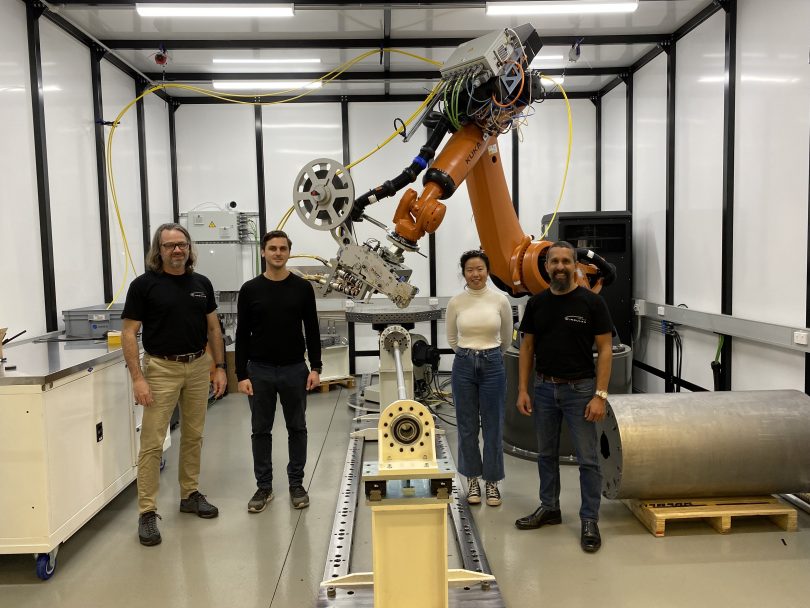
From left: Cingulan Space chief technology officer Joe Winter, ANU research fellow Dr Chris Stokes-Griffin, ANU student Rita Tri and Cingulan Space CEO Keith Rosario with a space antenna mast and robot. Photo: Supplied by Keith Rosario.
A space company in the regional NSW town of Yass has partnered with the Australian National University (ANU) in Canberra to develop and trial a strong, lightweight and heat-resistant material they hope will eventually be used to build rockets and spacecraft.
Cingulan Space and ANU’s Training Centre for Automated Manufacture of Advanced Composites (AMAC) recently completed a research project using a robot to manufacture an antenna mast wrapped in tape made from carbon fibres.
If it passes ANU’s manufacturing quality controls, the mast will be Australia’s first prototype of a spacecraft tracking appliance made from an advanced composite material, and will be tested on an antenna at Cingulan Space’s satellite tracking station in Yass.
This is a successful first step in a long-term plan to demonstrate advanced composite automated manufacturing for space vehicles, using ground-based vehicles and then aerospace vehicles, such as drones, to prove they can also be used to build rockets and spacecraft.
“Advanced composites are basically materials made from carbon fibres which makes them super strong and lightweight and gives them interesting thermal properties,” said Cingulan Space co-founder and CEO Keith Rosario.
“We have always been curious about these materials and during the past two years, we’ve been looking at the capability to apply advanced composite materials to Australia’s space industry.”
Mr Rosario said rocket manufacturers are looking for lightweight materials that are strong and can withstand launch temperatures to reduce the size and weight of the vehicle.
Why is there a space company in Yass?
Cingulan Space was established in Yass in 2016 to track overhead satellites and communicate with them using radio signals.
Now the company has satellite tracking stations in Yass and Wagin, in Western Australia, and soon it will build another in the Northern Territory to track satellites sent into space by a company in the US.
“There are more satellites up there than we can track,” said Mr Rosario.
“The number of satellites that could be in space is growing exponentially. Elon Musk with SpaceX (Space Exploration Technologies) is adding 36,000 satellites.”
Cingulan Space needs to be able to send and receive data from satellites, which could be anything from a photo or video, to moisture and mineral data.
Yass may seem a strange place for a satellite tracking station, however Mr Rosario said the town’s remoteness stops interference with the company’s radio signal technology.
As well as tracking satellites, the company has also been part of missions to launch satellites into space, and was a finalist for the Business of the Year category in the Australian Space Awards 2021.
Mr Rosario, who was also a finalist in the Executive of the Year category at the same awards, is keen to educate the next generation of space enthusiasts, and he often shares his time with schools in the Yass Valley for STEM (science, technology, engineering and maths) projects.
Partnering with ANU also meant one of the university’s students, Rita Tri, got the chance to be mentored by a real space company.
“It’s so important for undergraduates to have real contact with the industry,” said Mr Rosario. “I feel proud to work in this industry and believe I should pass that on.”
Cingulan Space will continue to collaborate with AMAC’s lead Professor Paul Compston and researchers Dr Chris Stokes-Griffin and Dr Peter Kreider to leverage the strength and thermal and lightweight benefits of carbon fibre composites for space sector applications.
Original Article published by Hannah Sparks on About Regional.












